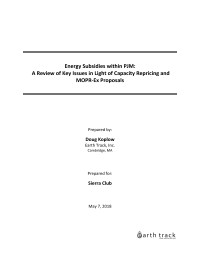Energy Subsidies within PJM: A Review of Key Issues in Light of Capacity Repricing and MOPR-Ex Proposals

In its proposed tariffs to remove potential distortions caused by subsidies in capacity markets, PJM includes a number of limitations and exclusions that appear to result in unequal evaluation of subsidies across different fuel cycles. This will likely impede PJM’s core objective of ensuring competitive, nondiscriminatory auctions in the wholesale capacity market. Because subsidies flow to all forms of generation, and nearly every upstream and downstream stage of each power-related fuel cycle as well, a comprehensive review process is needed if PJM is to address these subsidies in a neutral way.
- Blanket exclusion of federal and many state and local subsidies will reduce the accuracy of subsidy screening significantly. PJM excludes all federal subsidies, and any state or local support that is in place for regional economic development or to convince a plant to locate (or stay) in a particular region. Federal subsidies can be both large and highly targeted to an industrial facility. State and local subsidies excluded on the basis of their stated purpose can also be very large. They may represent multiple state programs, originating from more than one agency – some of which may be excluded and others not based on the PJM proposal. In all of these areas, it is the scale of support rather than the justification for granting it that will drive capacity market distortions.
- Revenue-based metrics for actionable subsidies need to be broadened to incorporate cost- and risk-reducing subsidies. Subsidies operate using three main levers: boosting revenues, reducing costs, and reducing the volatility of expected return by absorbing or capping credit, liability, or other operating risks. The PJM proposal, as currently worded, focuses only on revenues and as a result will not treat different power sources equally. If a policy of mitigating subsidies is to be pursued, then the materiality test should shift from 1% of revenues to “a subsidy equal in magnitude to one percent of revenues” to incorporate the broad array of subsidy mechanisms.
- Purchase mandates are one technique of many that governments use to transfer value to the energy sector; subsidy screening needs to incorporate all of them. Not every form of electrical power has the same cost structure. Some are capital-intensive, rolling out new technologies, or face long or uncertain build times. Others require complex fuel supply chains, have risks of severe accidents, or significant and complex post-closure concerns. Still others have variability in their ability to produce electricity. As a result of these differences, the importance of particular types of subsidy support varies significantly across fuels, and rules that by definition or effect limit review to a small subset of subsidy approaches will materially disadvantage some energy resources over others.
- PJM’s current focus almost entirely on purchase mandates will understate the level of subsidies to other forms of energy. In addition, where interventions are focused on internalizing environmental or health externalities that are not being addressed in other ways, PJM needs to evaluate the impact on efficiency using more than just generator costs of operation.
- Large subsidies to upstream or downstream fuel cycle steps need to be addressed to determine when a subsidy should be actionable. These types of supports are most relevant regarding subsidies to coal and natural gas extraction and transport; coal mine land reclamation; large state support to ancillary infrastructure to move or process fuels; or state subsidy for high risk, long-term parts of the nuclear fuel cycle.
- Subsidy combinations matter. If there are multiple subsidies flowing to the same beneficiaries that in total exceed PJM’s action threshold of support equal to 1% of revenues, these should be reviewed as a group for action even if individually they don’t hit 1%. Subsidy “stacking” is common across the world, and it is the joint effect of multiple subsidies that will drive the distortions in market behavior.
- Test case illustrates the importance of a more systematic inclusion of subsidies as potentially subject to PJM action. A test case relating to tax exemptions for coal in the state of Pennsylvania indicates that more subsidies than just purchase mandates would exceed the PJM’s proposed revenue threshold. Additional analysis would likely illustrate a similar situation in multiple other parts of PJM, though this one example is useful in illustrating why a narrow focus on purchase mandates will be insufficient in addressing potential distortions.

